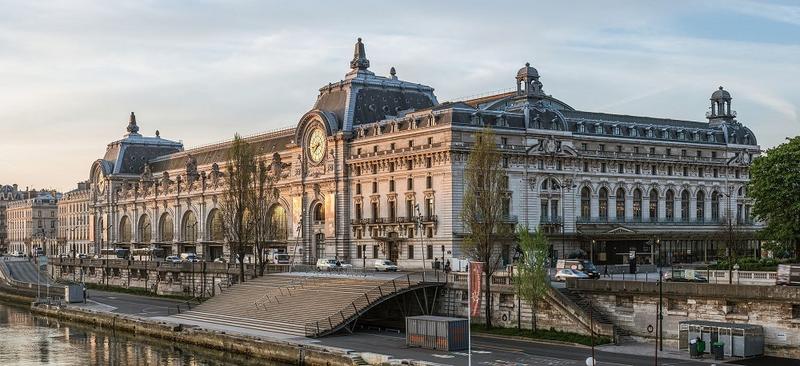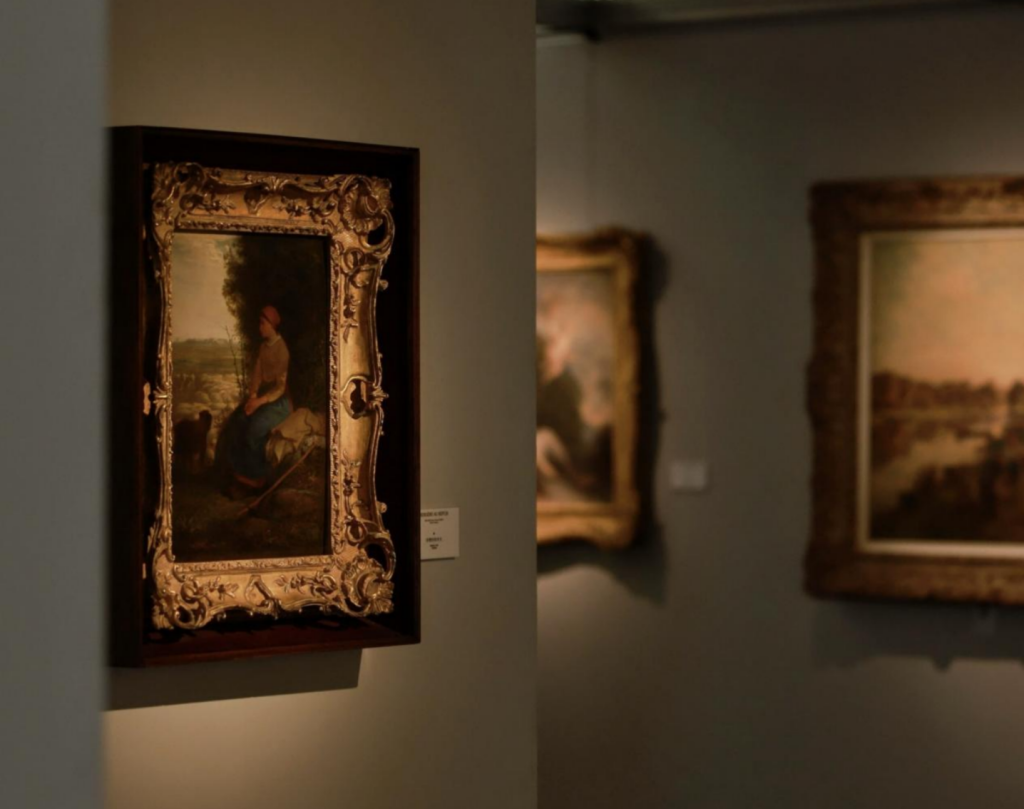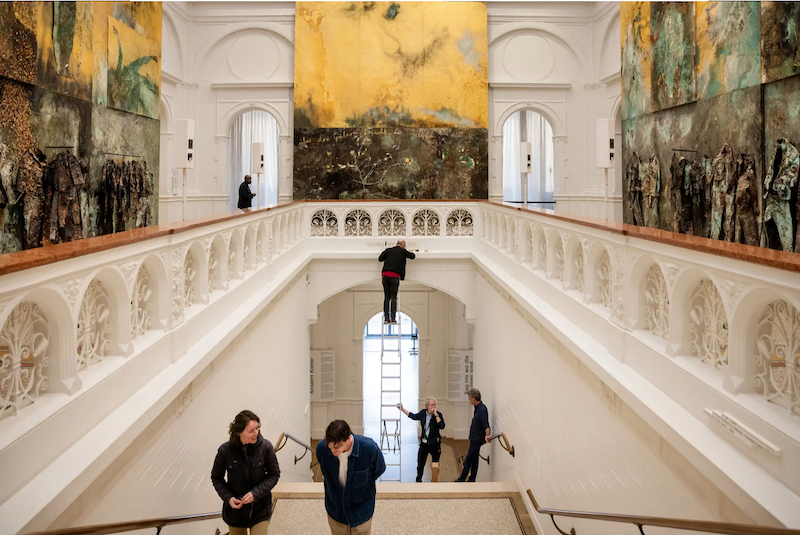
The Paper learned that "Paths to Modernity: Masterpieces from the Musée d'Orsay, Paris" will be held at the Pudong Art Museum on June 19.
This is the largest exhibition of the Musée d'Orsay in China so far. It will present hundreds of works, including Van Gogh's "Bedroom in Arles" and "Self-Portrait", Millet's "The Gleaners", Gauguin's "Tahiti Women", Monet's "Haystacks in Late Summer", Cezanne's "Portrait of Madame Cezanne", etc., covering almost all the important schools in the Musée d'Orsay's collection, including academic, academic, realist, naturalist, impressionist, neo-impressionist, post-impressionist, Nabis, etc. 21 years ago, a large number of Impressionist treasures of the Musée d'Orsay were also exhibited in Shanghai.

Vincent van Gogh, Bedroom in Arles, 1889, oil on canvas
Located on the left bank of the Seine in the center of Paris, the Musée d'Orsay was officially opened to the public in 1986. As one of the most important national museums in France, the museum mainly collects art treasures from 1848 to 1914, and is an authoritative representative of the artistic achievements of this era of drastic changes. It is particularly famous for its Impressionist and Post-Impressionist collections, and its collection size and artistic value are the largest in the world.

Musee d'Orsay, Paris
Pudong Art Museum and Musee d'Orsay jointly present "Creating Modernity: Art Treasures from the Musee d'Orsay in Paris", which will comprehensively present the competition, intersection and diversity of artistic ideas over the past decades. Those creative attitudes that break through tradition and explore the relationship between self and the times not only respond to the "modernity" issue of the time, but also reflect the light of the times in the second half of the 19th century and the early 20th century.
Important works on display include Van Gogh's "Bedroom in Arles" and "Self-Portrait", Millet's "The Gleaners", Gauguin's "Tahitian Women", Monet's "Haystacks in Late Summer", Manet's "Emile Zola", Degas' "Dancing Class at the Opera House, Rue Pelletier", Renoir's "Girl at the Piano", Cézanne's "Portrait of Madame Cézanne", Bonnard's "The White Cat", Signac's "Woman at the Well, Op. 238", and Cabanel's "The Birth of Venus". Among them, "The Gleaners" and "Tahitian Women" are included in textbooks.

Jean-François Millet, The Gleaners, 1857, oil on canvas © photo: Musée d'Orsay, Dist. RMN-Grand Palais / Patrice Schmidt
From the perspective of genre, this exhibition includes the realist master Millet, the founder of Impressionism Monet, as well as Manet, Renoir, Degas, the symbolist pioneer Gauguin, the post-Impressionist painter Van Gogh, the father of modernism Cezanne, the pointillist leader Seurat, and the Nabi representative Bonnard.

Edgar Degas, In the Café, 1875-1876, oil on canvas © photo : Musée d'Orsay, Dist. RMN-Grand Palais / Patrice Schmidt

Édouard Manet, Émile Zola, 1868, oil on canvas © photo : GrandPalaisRmn (Musée d'Orsay) / Patrice Schmidt
In addition to the masterpieces of paintings, sculptures are also an important dimension of this exhibition that cannot be missed. The exhibition will present more than 20 masterpieces of sculpture, including "Victor Hugo" by Rodin, the founder of modern sculpture, as well as Degas's "Ballet Dancers" series of bronze statues and Gauguin's wood carvings from the Tahiti period. The latter two works show the artists' pioneering exploration of expanding their personal artistic language through sculpture in addition to painting, reflecting the artistic trend and changes of cross-media experiments in the late 19th century.

Auguste Rodin, Victor Hugo, 1897, bronze © photo : Musée d'Orsay, Dist. RMN-Grand Palais / Patrice Schmidt
The last time a large number of works from the Musée d'Orsay were exhibited in Shanghai was in 2004, when the "French Impressionist Painting Treasures Exhibition" (which exhibited Manet's "Boy with Piccolo" and 51 other Impressionist works from the Musée d'Orsay in France) was exhibited. At that time, as a cultural exchange project between the two governments during the "China-France Cultural Year", the exhibition was successively exhibited in Beijing, Shanghai, and Hong Kong. It caused a sensation wherever it went. The three-story queues inside and outside became the norm during the exhibition period. Even in the last few days of the exhibition, the Shanghai Art Museum was open all night, which shows the enthusiasm of the public. After more than 20 years, the "Creating Modernity: Art Treasures from the Musée d'Orsay in Paris" at the Pudong Art Museum is even more anticipated.

At the end of 2004, during the "French Impressionist Painting Treasures Exhibition" at the Shanghai Art Museum, long queues formed at the entrance before the museum opened.
It is reported that the building of the Orsay Museum was originally the Orsay train station on the banks of the Seine. The original site was the old Audit Court. It was planned by the Paris-Orleans Railway Company after acquiring the land during the 1900 World Expo. It was an important facility built in time under the design of architects Lucien Magne, Emile Bernard and Victor Laloux. The project began in 1898 and was officially opened on July 14, 1900. At that time, it was equipped with a luxury hotel. In the planning, the Orsay train station was not just a traditional train station, but planned to create a more comfortable and luxurious space. Therefore, a sealed glass ceiling was designed to add a different decoration to the station. However, because the platform length did not meet the requirements of the new train, the Orsay train station was the terminus of the railway in southwestern France until the railway from Orleans to Paris was cancelled in 1939. During World War II, it was used as a gathering point for trains to the suburbs, prisoners of war to send packages, and a reception center for prisoners of war and exiles after the war.

Gare d'Orsay in the 1900s
In 1970, the station was allowed to be demolished. After the Minister of Cultural Affairs Jacques Duhamel rejected the plan to build a new hotel on the original site, he proposed the idea of converting it into a museum. The building was urgently included in the 1973 Supplementary List of Places of Interest and Monuments, and was finally rated as a monument in 1978. In addition, an architectural design tender was held that year, and the final museum reconstruction project was won by three young people from the ACT Architectural Office: Pierre Colboc, Renaud Bardon and Jean-Paul Philippon. Later, some of the collections originally stored in the Louvre, the National Tennis Court Modern Art Museum and the National Museum of Modern Art (Pompidou Center) were gradually transferred to the Orsay Museum.

Sculpture Exhibition Hall
After undergoing a very large restoration project and completing the collection and exhibition of more than 2,000 paintings, 600 sculptures and other works, the Musée d'Orsay was officially opened to the public in December 1986 under the auspices of then-President François Mitterrand.
The Musée d'Orsay has 80 exhibition halls on five floors, with a display area of 47,000 square meters. The total number of collections is about 97,000, covering paintings, prints, sculptures, furniture, architecture, decorative arts, photography and other fields. The exhibits in the museum are divided by era and genre. The bottom floor: exhibits paintings, sculptures and decorative art works from 1850 to 1870; the middle floor: exhibits works from 1870 to 1914, including official art during the Third Republic, symbolism, academic painting and decorative art during the Art Nouveau period; the top floor: focuses on the works of Impressionist and Post-Impressionist painters.

Impressionist Hall
The Pudong Art Museum’s exhibition was specially designed by the famous French exhibition designer Cécile Degos, who took the interior of the Musee d’Orsay as inspiration and combined it with the spatial structure of the Pudong Art Museum to create an immersive exhibition experience.
More exhibition works:

Paul Cézanne, Portrait of Madame Cézanne, 1885-1890, oil on canvas © photo : RMN-Grand Palais (Musée d'Orsay) / Hervé Lewandowski

Edgar Degas, "Dancing Class at the Opera, Rue Pelletier", 1872, oil on canvas © photo : RMN-Grand Palais (Musée d'Orsay) / Tony Querrec

Charles-François Daubigny, Spring, 1857, oil on canvas © photo : RMN-Grand Palais (Musée d'Orsay) / Hervé Lewandowski

Alexandre Cabanel, The Birth of Venus, 1863, oil on canvas © photo : Musée d'Orsay, Dist. RMN-Grand Palais / Patrice Schmidt

Gustave Courbet, The Wounded Man (Self-Portrait), 1844-1854, oil on canvas © photo : Musée d'Orsay, Dist. RMN-Grand Palais / Patrice Schmidt

Auguste Renoir, Girl at the Piano, 1892, oil on canvas © photo : Musée d'Orsay, dist. GrandPalaisRmn / Patrice Schmidt

Ernest Meissonier, The French Campaign of 1814, 1864, oil on wood © photo : Musée d'Orsay, Dist. RMN-Grand Palais / Patrice Schmidt

Georges Seurat, Model from the Back, 1887, oil on wood © photo : Musée d'Orsay, Dist. RMN-Grand Palais / Patrice Schmidt

Vincent van Gogh, Self-Portrait, 1887, oil on canvas © photo : Musée d'Orsay, Dist. RMN-Grand Palais / Patrice Schmidt

Henri de Toulouse-Lautrec, Justine Dieule, also known as Women in the Garden, oil on cardboard © photo : Musée d'Orsay, Dist. RMN-Grand Palais / Patrice Schmidt

Claude Monet, Haystacks, Late Summer, 1891, oil on canvas © photo : Musée d'Orsay, Dist. RMN-Grand Palais / Patrice Schmidt

Paul Signac, Woman at the Well, Opus 238, 1892, oil on canvas © photo: Musée d'Orsay, Dist. RMN-Grand Palais / Patrice Schmidt

Pierre Bonnard, The White Cat, 1894, oil on cardboard © photo : Musée d'Orsay, Dist. RMN-Grand Palais / Patrice Schmidt

Pierre Bonnard, Joy, 1906-1910, oil on canvas, donated by Antoine d'Offe in 1980 © photo : Musée d'Orsay, Dist. RMN-Grand Palais / Patrice Schmidt

Alfred Sisley, Boats in the Flood at the Port of Marly, 1876, oil on canvas © photo : Musée d'Orsay, dist. RMN-Grand Palais / Patrice Schmidt

Camille Pissarro, "Red roofs of a village in winter", 1877, oil on canvas © photo: Musée d'Orsay, Dist. RMN-Grand Palais / Patrice Schmidt

Jules Bastien-Lepage, Hay, 1877, oil on canvas © photo : RMN-Grand Palais (Musée d'Orsay) / Hervé Lewandowski

Paul Gauguin, Tahitian Women, also known as On the Beach, 1891, oil on canvas © photo : Musée d'Orsay, Dist. RMN-Grand Palais / Patrice Schmidt

Claude Monet, Rocks on the Wild Coast of Belle-Isle, 1886, oil on canvas © photo : Musée d'Orsay, Dist. RMN-Grand Palais / Patrice Schmidt

Édouard Manet, Woman with a Fan, 1873-1874, oil on canvas © photo : Musée d'Orsay, Dist. RMN-Grand Palais / Patrice Schmidt


